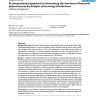109
Voted
BMCBI
2006
15 years 1 months ago
2006
Background: The identification of patterns in biological sequences is a key challenge in genome analysis and in proteomics. Frequently such patterns are complex and highly variabl...
99
Voted
BMCBI
2006
15 years 1 months ago
2006
Background: Phytochromes are photoreceptors, discovered in plants, that control a wide variety of developmental processes. They have also been found in bacteria and fungi, but for...
109
click to vote
BMCBI
2008
15 years 1 months ago
2008
Background: Classification of protein sequences is a central problem in computational biology. Currently, among computational methods discriminative kernel-based approaches provid...
130
Voted
BMCBI
2008
15 years 1 months ago
2008
Background: Protein remote homology detection and fold recognition are central problems in bioinformatics. Currently, discriminative methods based on support vector machine (SVM) ...
91
Voted
BMCBI
2007
15 years 1 months ago
2007
Background: False occurrences of functional motifs in protein sequences can be considered as random events due solely to the sequence composition of a proteome. Here we use a nume...
114
Voted
BMCBI
2008
15 years 1 months ago
2008
Background: Many proposed statistical measures can efficiently compare protein sequence to further infer protein structure, function and evolutionary information. They share the s...
107
click to vote
BMCBI
2008
15 years 1 months ago
2008
Background: Amino acids responsible for structure, core function or specificity may be inferred from multiple protein sequence alignments where a limited set of residue types are ...
BMCBI
2007
15 years 1 months ago
2007
Background: Over the past decade, a number of tools have emerged for the examination of homology relationships among protein sequences in a structural context. Most recent softwar...
BMCBI
2007
15 years 1 months ago
2007
Background: The presence of gaps in an alignment of nucleotide or protein sequences is often an inconvenience for bioinformatical studies. In phylogenetic and other analyses, for ...
100
click to vote
BMCBI
2007
15 years 1 months ago
2007
Background: The rapid burgeoning of available protein data makes the use of clustering within families of proteins increasingly important. The challenge is to identify subfamilies...





